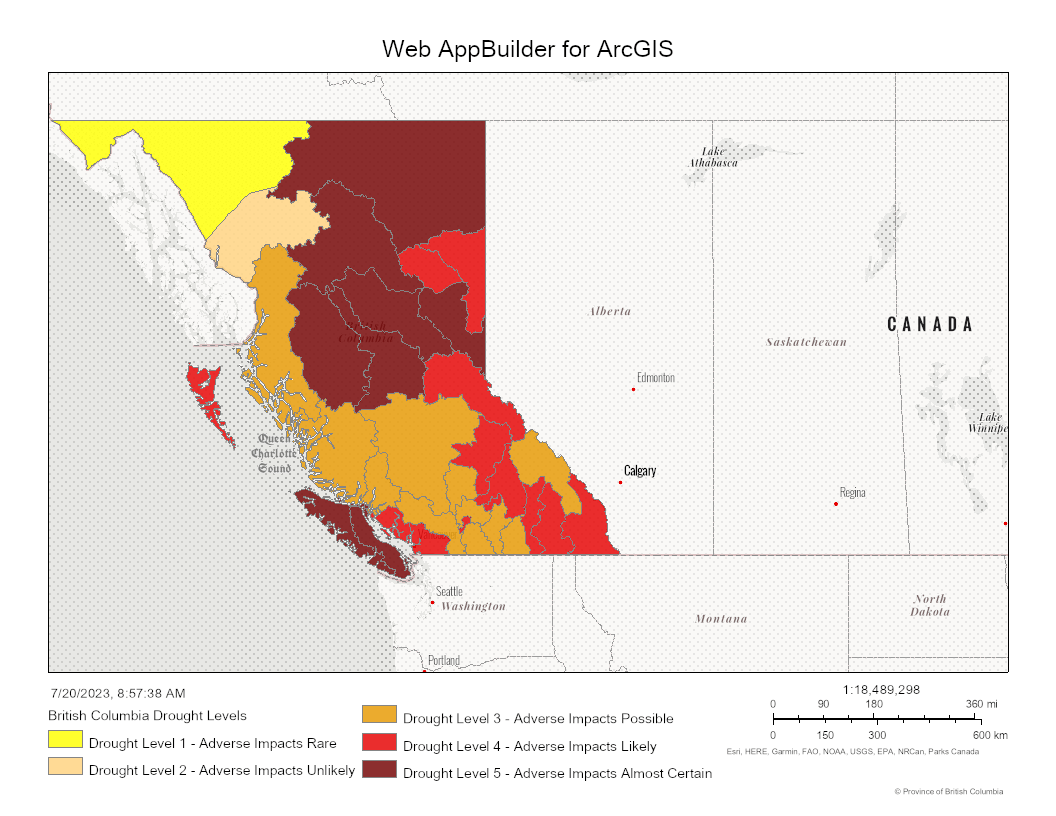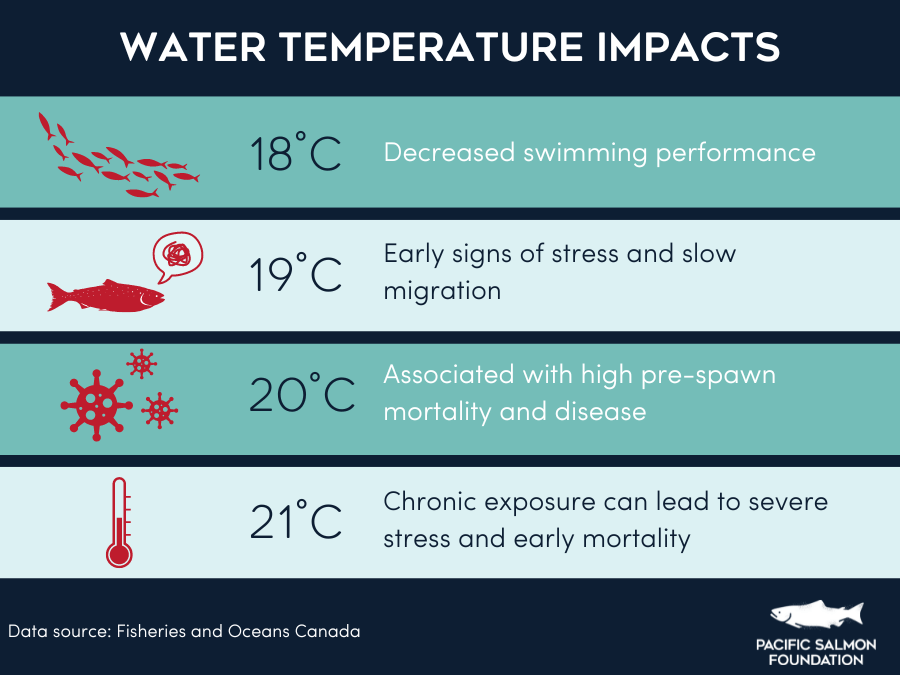B.C. forecasts provincial drought this summer. How can we help salmon survive?
Jul 20, 2023|inBlog, Climate Adaptation Series
As the province warns of “long-term, significant drought” this summer, impacts on salmon are imminent. While those exact impacts are to be determined, PSF and partners seek innovative, cost-effective solutions to help salmon adapt.
In June, the Province of British Columbia forecasted a high risk of province-wide drought for the summer of 2023 due to a combination of natural factors and climatic conditions. While B.C. has suffered from droughts before, even as recently as 2022, conditions this year indicate prolonged, severe drought across essentially the entire province.
Given that extreme drought conditions threaten the survival of both adult and juvenile Pacific Salmon, the Pacific Salmon Foundation (PSF) is working with partners to explore innovative solutions to improve survival odds for salmon during extreme drought. PSF is also preparing to respond to emergency drought-induced salmon projects.
“Salmon across B.C. are profoundly vulnerable to the effects of climate change,” says Jason Hwang, Vice President of Salmon at PSF. “While enduring these climate change realities, it’s important to recognize that salmon are resilient. They have adapted for thousands of years. Climate change is their greatest threat so far, and it’s our job to embrace opportunities that enhance the resilience of salmon to extreme climate events.”
As of July 20, 2023, eight of 34 water basins in B.C. are at Level Five drought, the most severe drought ranking according to the British Columbia Drought Information Portal. At Level Five, adverse socio-economic or ecological impacts are almost certain.
Additionally, 24 water basins are currently at Level Three and Four droughts, meaning adverse impacts are likely or possible. That leaves only two basins – Stikine and Northwest – at safe levels where adverse drought impacts are not currently anticipated.

B.C. drought level map on July 20, 2023. (British Columbia Drought Information Portal)
This year’s drought conditions in B.C. are so extreme that they are being characterized by outlier conditions. In June, the Province noted that “many rivers are already at or near the lowest flows on record for this time of year.” Uncharacteristically low river flows and high water temperatures are two drought-related factors that can reduce salmon survival and reproductive success. Salmon start to feel stress at water temperatures of 17°C, and temperatures above 21°C can be lethal.
In the Fraser River, water temperatures are relatively high and flows are low compared to what is typical at this time of year. According to the Fraser River Environmental Watch Report issued on July 13, 2023, some water temperature measurements are already above 20°C and some areas are recording temperatures five degrees above normal for this time of year.
In the Cowichan River below Lake Cowichan on Vancouver Island, which is experiencing Level Five drought, water temperatures in July have exceeded 23°C in the early evenings according to real-time data from the Water Survey of Canada. The coolest water temperatures of the day recorded in the mornings have been around 19°C in early July, but have climbed upwards to 21°C more recently.
Drought conditions are often tied to low flows and dry rivers and creeks. Without sufficient water in streams, adult salmon may not successfully be able to migrate upstream and access their spawning grounds. Low flows can de-water critical juvenile salmon habitat, which can lead to juvenile stranding in dried-out pools and can cause significant mortalities and reduced returns in future years. Small salmon-bearing streams are particularly vulnerable to drought because they have a lower volume of water to begin with and dry out much easier. This is particularly challenging for juveniles that spend one year or longer in freshwater habitat before migrating to the ocean.
The other significant drought-induced problem salmon face is high water temperatures. Salmon can only tolerate a limited thermal threshold. Elevated water temperatures can cause on-route mortalities for adult salmon returning to their freshwater spawning grounds. Like humans, salmon expend more energy in a warm environment, so they may have decreased survival odds due to factors such as reduced ability to avoid predators. Even if they reach their spawning grounds, they might not have enough energy remaining to successfully reproduce. Warm water temperature also increases potential impacts from pathogens and disease.

Drought increases overall stress for fish, creating a greater probability of mortality for both adult and juvenile salmon.
As an additional problem, low flows and warm waters can delay access to spawning grounds, which can alter the natural timing of reproduction. If salmon eggs face delays in hatching, the juveniles may face further barriers to survival in terms of seasonal food availability. One drought season has the potential to impact two generations of salmon – adults actively trying to spawn and juveniles from adults that spawned one year ago and that live in freshwater for more than a year.
“There’s no doubt that drought can be devastating for salmon populations. Just last year, we observed significant drought-related salmon mortalities and delays in many salmon runs,” says Hwang. “This year, we’re facing severe drought conditions that I’ve never seen this widespread in my lifetime. We need to do everything we can to help salmon in the face of this extreme drought, and we think it’s time to try ideas that we have never tried before.”
As forecasts on B.C.’s forthcoming drought began circulating in late spring, PSF engaged with partners from Fisheries and Oceans Canada (DFO), the B.C. Ministry of Water, Land, and Resource Stewardship (WLRS), First Nations Fisheries Council, and others to discuss ideas to help salmon adapt to these dry and warm conditions.
Currently, PSF and partners are researching strategies and tactics that have been used in other jurisdictions and exploring new, innovative tactics that have not been deployed before in B.C that could be implemented this summer.
“We are looking at strategies that are brand new and may seem unconventional, but we’ve also never seen drought conditions of this severity. We’re facing a ‘perfect storm’ of drought conditions that could be disastrous for salmon, and we need to be willing to try new and innovative ideas to match the scale of the problem. Standing by and doing nothing is not an option,” says Hwang.
Some of the strategies being examined include shading sensitive habitat using temporary, low-cost materials to cool streams, and digging deeper pools to ensure salmon have access to cooler and deeper refuge areas that may help them to survive the drought.
This project is ongoing and PSF will continue to provide updates on implementation and outcomes.
Water temperatures and flows will be driven by natural conditions, but humans can play a role in water use and ensuring there is enough water for salmon and the aquatic ecosystem. Here are some potential strategies that can be used during drought conditions:
“Unfortunately, our new reality is that we will continue to see a greater frequency of extreme climate-related events. These are not once-in-a-while issues,” says Hwang. “We believe that it is possible to support salmon through these emergencies and plan for a more sustainable future. It will take all of us working together, but if we put our commitment and focus towards making things better, we can help to ensure that salmon and our watersheds will be healthy for future generations.”
Sustainable drought management will also require medium- to long- term measures that will help enhance salmon resilience to climate change into the future. Stay tuned for further comments from PSF on long-term planning for climate change.
July 28, 2023: CBC News interviewed Jason Hwang, PSF’s VP of Salmon about the severe drought conditions:

 DFO science advice processes need overhaul, say scientists
DFO science advice processes need overhaul, say scientists